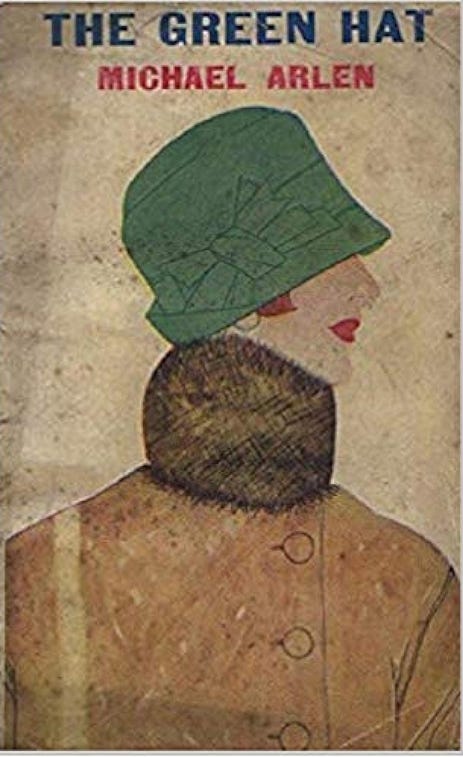Hi everyone,
This week, I want to keep it simple and share with you with another piece of research I wish I could have found room for in Part One.
In 1924, novelist Michael Arlen published The Green Hat, a roman à clef (meaning a novel that’s really a thinly-disguised memoir). Set in London in the 1920s, The Green Hat — which was scandalous at the time of publication — explores the lives of the “Bright Young Things,” one of the between-the-wars attempts by the younger generation to push back against the mythological story of “suffer now, rewards later” that we talked about in episode 1:1 “Kairos.”
As we went on to talk about in episode 1:2 “Love Lies Bleeding,” movements like the Bright Young Things didn’t have quite all of the necessary ingredients to start and sustain a culture-changing revolution. But what they did have was the restless, intuitive knowledge that there was more to life than “suffer now, rewards later.” And having lived through (or not, as the case may be) the global destruction of World War I, that generation was starting to suspect that “might makes right” was not the way to a better life.
Here’s a passage from The Green Hat that articulates that longing—
“They call it the desire-for-I-know-not-what. They will find it one day when we are dead and all things that live now are dead. They will find it when everything is dead but the dreams we have no words for. It is not chocolate, it is not cigarettes, it is not cocaine, nor opium, nor sex. It is not eating, drinking, flying, fighting, loving. It is not love’s delight, it is not bearing children, though in that there are moments like jewels. There is one taste in us that is unsatisfied. I don’t know what that taste is, but I know it is there. Life’s best gift, hasn’t some one said, is the ability to dream of a better life....”
In episode 1:2, we also talked about how this “ability to dream of a better life” is by far the most important legacy of the Love Revolution. Today, every single one of us takes that ability to dream of a better life for granted, but that ability simply did not exist for most people in any meaningful way prior to the Sixties.
However important the more specific cultural and political changes were during the Sixties (and they were, of course, significant), it’s this newfound ability — this freedom — to dream of a better life that made the Sixties into only the second riverbed-changing earthquake in recorded history.
But as we talked about in episode 1:7 “The Measure of a Man,” the ability to actually create that better life is what we lost when we allowed fear of softness to turn us away from the new story of the Love Revolution and back towards the old story of “suffer now, rewards later” and it’s twisted parent “might makes right.” And as we stepped through in detail in episode 1:7, much of that turning away happened as a result of the way in which we collectively experienced (and continue to experience) the breakup of The Beatles.
This is why it’s so important that we heal the wound in our collective story of the Sixties and of The Beatles — the underlying mythological story that gave us that freedom to dream of and create a better life. And we begin that healing, from a mythological perspective, by restoring the love to the heart of the story of The Beatles— which is what The Abbey and Beautiful Possibility are all about.
There’s one more curious thing to notice about The Green Hat, relative to our story.
Rory Storm was the front man for Rory Storm & the Hurricanes, another prominent Liverpool band whose drummer left in 1962 to become a Beatle. Rory Storm is the stage name for Alan Caldwell, who had a sister named Iris who briefly dated both George Harrison and Paul McCartney (not at the same time). Combine Rory’s stage name with his sister’s actual first name, and you get Iris Storm — the name of the main character in The Green Hat.
The Green Hat was a bestseller in 1924, but I have no information to offer re: whether the novel might have influenced either Rory Storm’s stage name (seems unlikely) or the naming of his sister (seems more likely).
I’m not in any way at all suggesting this name situation has any deep meaning relative to the larger story we’re telling here. It’s just a smalll, curious coincidence.
Until next week.
Peace, love, and strawberry fields,
Faith ❤️
PS If you’re subscribed to The Abbey, you’ll find in your inbox tomorrow morning a monthly digest email with links to all of the past month’s updates. If you’re not yet subscribed and you’d like to receive this monthly digest email, you can subscribe here:



